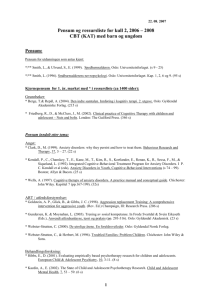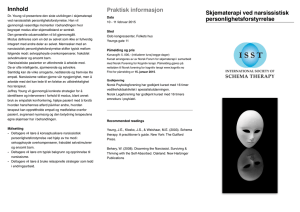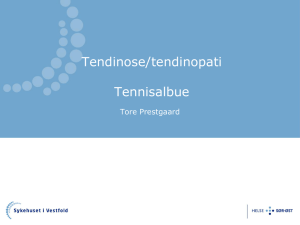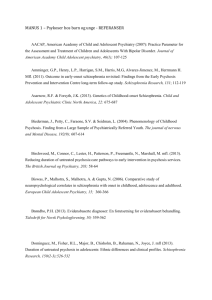CBT (KAT) med barn og ungdom
advertisement
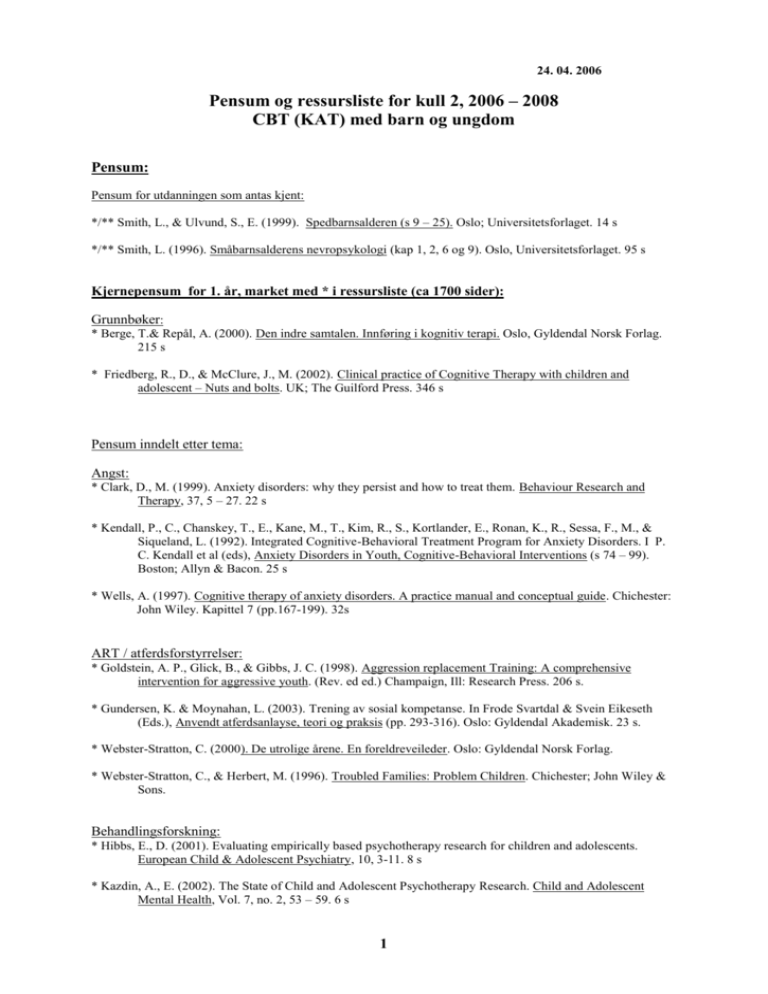
24. 04. 2006 Pensum og ressursliste for kull 2, 2006 – 2008 CBT (KAT) med barn og ungdom Pensum: Pensum for utdanningen som antas kjent: */** Smith, L., & Ulvund, S., E. (1999). Spedbarnsalderen (s 9 – 25). Oslo; Universitetsforlaget. 14 s */** Smith, L. (1996). Småbarnsalderens nevropsykologi (kap 1, 2, 6 og 9). Oslo, Universitetsforlaget. 95 s Kjernepensum for 1. år, market med * i ressursliste (ca 1700 sider): Grunnbøker: * Berge, T.& Repål, A. (2000). Den indre samtalen. Innføring i kognitiv terapi. Oslo, Gyldendal Norsk Forlag. 215 s * Friedberg, R., D., & McClure, J., M. (2002). Clinical practice of Cognitive Therapy with children and adolescent – Nuts and bolts. UK; The Guilford Press. 346 s Pensum inndelt etter tema: Angst: * Clark, D., M. (1999). Anxiety disorders: why they persist and how to treat them. Behaviour Research and Therapy, 37, 5 – 27. 22 s * Kendall, P., C., Chanskey, T., E., Kane, M., T., Kim, R., S., Kortlander, E., Ronan, K., R., Sessa, F., M., & Siqueland, L. (1992). Integrated Cognitive-Behavioral Treatment Program for Anxiety Disorders. I P. C. Kendall et al (eds), Anxiety Disorders in Youth, Cognitive-Behavioral Interventions (s 74 – 99). Boston; Allyn & Bacon. 25 s * Wells, A. (1997). Cognitive therapy of anxiety disorders. A practice manual and conceptual guide. Chichester: John Wiley. Kapittel 7 (pp.167-199). 32s ART / atferdsforstyrrelser: * Goldstein, A. P., Glick, B., & Gibbs, J. C. (1998). Aggression replacement Training: A comprehensive intervention for aggressive youth. (Rev. ed ed.) Champaign, Ill: Research Press. 206 s. * Gundersen, K. & Moynahan, L. (2003). Trening av sosial kompetanse. In Frode Svartdal & Svein Eikeseth (Eds.), Anvendt atferdsanlayse, teori og praksis (pp. 293-316). Oslo: Gyldendal Akademisk. 23 s. * Webster-Stratton, C. (2000). De utrolige årene. En foreldreveileder. Oslo: Gyldendal Norsk Forlag. * Webster-Stratton, C., & Herbert, M. (1996). Troubled Families: Problem Children. Chichester; John Wiley & Sons. Behandlingsforskning: * Hibbs, E., D. (2001). Evaluating empirically based psychotherapy research for children and adolescents. European Child & Adolescent Psychiatry, 10, 3-11. 8 s * Kazdin, A., E. (2002). The State of Child and Adolescent Psychotherapy Research. Child and Adolescent Mental Health, Vol. 7, no. 2, 53 – 59. 6 s 1 Depresjon: * Harrington, R. (2004). Depressive disorders. I P. J. Graham, Cognitive Behaviour Therapy for Children and Families (s 263 - 280). Cambridge: Cambridge University Press. 17 s. * Reinecke, M., A., Ryan, N., E., & DuBois, D. L.(1998). Cognitive - behavioral therapy for depression and depressive symptoms during adolescents: A review and meta-analysis. Journal of the American Academy of Child and Adolescent Psychiatry, 37, 26-34. 8 s. * Wood , A., Harrington, R., & Moore, A.(1996). Controlled trial of brief cognitive-behavioral interventions in adolescent patients with depressive disorders. Journal of child Psychology and Psychiatry, 37, 737-746 Metode / teori: * Haga A., & Davison G., C. (1998). Cognitive Change Methods. I F. H. Kanfer & A. P. Goldstein, (red) Helping People Change. A Textbook of Methods (s 236-276). New York; Pergamon General Psychology series. 40 s * Kendall, P., C. (2000). Guiding Theory for Therapy with Children and Adolescent. I P., C. Kendall, Child & Adolescent Therapy–Cognitive-Behavioral Procedures (s 3 – 25). New York; The Guildford Press. 22 s MST: * Ogden, T. & Halliday-Boykins,C. (2004). Multisystemic treatment of antisocial adolescents in Norway. Replication of clinical outcomes outside of the U.S. Child and Adolescent Mental Health, 9, 77-83. 6s. * Patterson, G. R. (2002). The early development of coercive process. I J.B.Reid, R.Patterson, &J.Snyder (Eds.), Antisocial behavior in children and adolescents. A developmental analysis and model for intervention (ss.25-45). Washington, DC: American Psychological Association. 20 sider * Schoenwald, S. K., Brown, T.L. & Henggeler, S.W. (2000). Inside Multisystemic Therapy: Therapists, Supervisory and Program Practices. Journal of Emotional and Behavioral Disorders. 8 (2), 113 – 127 Psykoser; * Berge og Repål (2004). Kognitiv terapi ved personlighetsforstyrrelser (200 - 228). I Berge og Repål, Den Indre samtalen. Kognitiv terapi i praksis. (2. utgave). Oslo, Gyldendal Norsk Forlag. 28 s. * Jansen og Repål (2001). Kognitiv terapi ved paranoide vrangforestillinger. Temanummer om kognitiv terapi, Tidsskrift for Norsk Psykologforening, 38, 746-753. 7s. Rus: * Beck, A. T., Wreight, F. D., Newman, C. F. & Liese, B. S (1993). Cognitive Therapy of substance abuse. NY. The Guilford Press. Kap. 1,2,3 og 5, tilsammen 70 sider Små barn: * Knell, S. M. (1993). Cognitive – Behavioral Play Therapy, (s 5 – 115). London; Jason Aronson Inc. 110 s * Ronen, T. (1997). Cognitive Developmental Therapy with Children. Chichester; John Wiley & Sons. (utvalgte kap) Spiseforstyrrelser: * Fairburn, C. G., Cooper, Z., & Shafran, R. (2003). Cognitive behaviour therapy for eating disorders: A "transdiagnostic" theory and treatment. Behaviour Research and Therapy, 41, 509-528.19 sider * Fairburn, C. G. & Harrison, P. J. (2003). Eating disorders. Lancet, 361, 407-416. 9 sider * Fairburn, C. G., Marcus M. D., & Wilson G. T. (1993). Cognitive-Behavioral Therapy for Binge Eating and Bulimia Nervosa: A comprehensive Treatment Manual. In C. G. Fairburn & G. T. Wilson (Eds.), Binge eating: Nature, assessment, and treatment (pp. 317-404), 87 sider 2 * Geller, J., Williams, K., & Srikameswaran, S. (2001). Clinician stance in the treatment of chronic eating disorders. European Eating Disorders Review, 9, 1-9. 9 sider Anbefalt litteratur (ikke pensum): Beck, J. S. (1995). Cognitive Therapy. Basic and Beyond. London; Guilford Press. 313 s Graham, P. (1998). Cognitive-Behaviour Therapy for Children and Families. UK; Cambridge University Press. 285 s Karoly, P., & Harris, A. (1998). Operant Methods. I F., H. Kanfer & A. P. Goldstein, (red) Helping People Change. A Textbook of Methods (s 111 – 139). New York; Pergamon General Psychology series. 28 s. Sturmey, P. (1996). Process issues I: As, Bs, and Cs. I P. Sturmey, Functional Analysis in Clinical Psychology ( s 147 – 203). Chichester; Wiley. 50 s. 3 Kjernepensum for 2. år, market med ** i ressursliste (ca 1400 sider): Grunnlitteratur: ** Graham, P. (2005). Jack Tizard Lecture: Cognitive behaviour therapies for children: passing fashion or here to stay? Child and Adolescent Mental Health, 10 (2), 57-62. ** Leahy, R. L. (2003). Roadblocks in Cognitive-Behavioral Therapy - Transforming challenges into opportunities for change. New York: The Guilford Press. Kap 1 - 6. (s.3 -134) 131s. ** Reinecke, Dattilio & Freeman (2003). Cognitive therapy with children and adolescents - A casebook for clinical practice (2. ed). The Guilford Press, NY. kap 1 - 8, 10, 15 og 16. Ca 300 sider. ** Reinecke & Clarck (2004). Cognitive therapy across the lifespan - Evidence and Practice. Cambridge University Press, UK. Kap. 1, 9 – 10, 14 – 20. Ca 265 sider ART / Atferdsforstyrrelser: ** Henggeler, S., W. Schoenwald, S. K., Borduin, C. M., Rowland, M. D., & Cunningham, P. B. (1998). Multisystemic treatment of antisocial behavior in children and adolescents. New York: Guildford Press. 287 sider ** Kendall, P., C. & Braswell, L. (2002). Cognitive-Behavioral Therapy for Impulsive Children (2nd ed.). New York; The Guilford Press. 239 sider. Behandlingsforskning: ** Peterman, F., & Muller, J., M. (2001). Clinical Psychology & Single-case Evidence. A practical approach to Treatment, Planning & Evaluation. UK; John Wiley & Sons Ltd. 171 s Forebyggende arbeid: ** Neumer, S. & Junge, J. (2000). Primær forebygging av psykiske lidelser. Revidert og oversatt til norsk fra det originale tyske manuskriptet Neumer, S. & Junge, J. (2000). Primäre Prävention psychischer Störungen. In F. Jacobi & A. Poldrack (Eds.), Klinisch-psychologische Forschung. Ein Praxishandbuch (S.267-282). Göttingen: Hogrefe. 15 sider ** Jane-Llopis. E., Hosman, C., Jenkins, R., & Anderson, P. (2003). Predictors of efficacy in prevention programs. Meta-analysis. British Journal of Psychiatry, 183, 284 – 397. 13 sider ** Shortt, A. L., Barrett, P. M. and Fox, T. L. (2001). Evaluating the FRIENDS Program: A cognitive-behavioral group treatment for anxious children and their parents. Journal of Clinical Child Psychology, Vol. 30, No. 4, 525 – 535. 10 sider Motivasjon: **Miller og Rollnick (2002) Motivational Interviewing, 2nd Ed: Preparing people for change. Kap 1,2,3,5. 38s **Prescott og Børtveit (2004) Helse og atferdsendring, Gyldendal, kap 10 og 11, 22 sider OCD: ** Berge, T. & Vogel, P., A.. (2002). Psykoterapeutisk arbeid ved tvangstanker - en kognitiv tilnærming. I T. Berge, E., D., Axelsen, G. H. Nielsen, I., H., Norhus,& R. Ommundsen (red), Samtaler som forandrer. Psykologisk teori i praksis. Bergen: Bokforlaget. ** Englyst, Inger (2002). Psykologisk behandling av OCD hos børn og unge (177 – 239). I P. Hove Thomsen (red), OCD hos børn og unge, København, Psykologisk forlag A/S. 62 sider 4 Personlighetsforstyrrelser: ** Nordahl, H.M. (1996). Kognitiv kasusformulering ved personlighetsforstyrrelser. Tidsskrift for Norsk Psykologforening, 33, 1065-1072. 7 sider ** Nordahl. H.M. & Stiles, T.C. (1997). Conceptualisation and identification of cognitive schemas in personality disorder. Nordic Journal of Psyciatry, 51, 243-250. 7 sider PTSD: ** Foa, E. B., Keane, T. M., & Friedman, M. J. (2004). Effective treatments for PTSD: Practical guidelines from the International Society for Traumatic Stress Studies. London: The Guilford Press. 388 sider Selvfølelse: **Fennell, M. (1999). Overcoming low self-esteem. A self-help guide using Cognitive -Behavioral techniques. UK, Constable & Robinson Ltd. Selvskading: ** Fabricius, A. M. og Mørch, M. M. (1998). Kognitiv terapi ved selvbeskadigelse i Kognitiv behandling av skizofreni, kap 7. Hans Reutzels Forlag A/S. 12 sider ** Mørch, M. M. og Fabricius, A. M. (2001). Kognitiv terapi av unge med impulsforstyrrelser. Tidsskrift for Norsk Psykologforening, 725 – 734. 9 sider [Pensum totalt består av 3600 (begge år) hvorav 500 sider skal være selvvalgt. 1. års pensum utgjorde 1700 sider, 2 års pensum 1400 sider] ************************ 5 Ressursliste: litteratur inndelt etter tema: Grunnleggende om teori og metode i CBT: * Beck, J. S. (1995). Cognitive Therapy. Basic and Beyond. London; Guilford Press. * Berge, T., & Repål, A. (2000). Den indre samtalen. Innføring i kognitiv terapi. Oslo, Gyldendal Norsk Forlag * Friedberg, R., D., & McClure, J., M. (2002). Clinical practice of Cognitive Therapy with children and adolescent – The nuts and bolts. New York; Guilford press. ** Graham, P. (2005). Jack Tizard Lecture: Cognitive behaviour therapies for children: passing fashion or here to stay? Child and Adolescent Mental Health, 10 (2), 57-62. * Graham, P. (1998). Cognitive-Behaviour Therapy for children and families. UK; Cambridge University Press. * Haga A., & Davison G.C. (1998). Cognitive Change Methods I F. H. Kanfer & A. P. Goldstein, (red) Helping People Change. A Textbook of Methods (s 236-276). New York; Pergamon General Psychology series. Karoly, P., & Harris, A. (1998). Operant Methods. I F., H. Kanfer & A. P. Goldstein, (red) Helping People Change. A Textbook of Methods (s 111 – 139). New York; Pergamon General Psychology series. Kendall, P.C. (2000) Child and Adolescent Therapy, Cognitive- Behavioral Procedures. (2nd ed). UK; The Guilford Press. * Kendall, P., C. (2000). Guiding Theory for Therapy with Children and Adolescent. I P., C. Kendall, Child & Adolescent Therapy – Cognitive-Behavioral Procedures (s 3 – 25). New York; The Guildford Press. Kognitiv terapi (2001). Tidsskrift for Norsk Psykologforening. nr.8 (temanummer). ** Leahy, R. L. (2003). Roadblocks in Cognitive-Behavioral Therapy - Transforming challenges into opportunities for change. NY, The Guilford Press. Kap 1 - 6. Mc Mullin, R. E. (1999). The New Handbook of Cognitive Therapy Techniques. New York; W. W. Norton & Company. ** Reinecke & Clarck (2004). Cognitive therapy across the lifespan - Evidence and Practice. UK; Cambridge University Press. Kap. 1, 9 – 10, 14 – 20. * Reinecke, Dattilio & Freeman (2003). Cognitive therapy with children and adolescents - A casebook for clinical practice (2. ed). London; The Guilford Press. kap 1 - 8, 10, 15 og 16. Sturmey, P. (1996). Process issues I: As, Bs, and Cs. I P. Sturmey, Functional Analysis in Clinical Psychology ( s 147 – 203). Chichester; Wiley. Litteratur etter tema: Angst: Berge, T. & Repål, A. (2000):Trange rom og åpne plasser. Hjelp til mestring av angst, panikk og fobier. (2.utg.) Oslo; Aschoug Forlag. * Clark, D., M. (1999). Anxiety disorders: why they persist and how to treat them. Behaviour Research and Therapy, 37, 5 – 27. Flannery-Schroeder, E. & Kendall, P., C.(1997). Cognitive-Behavioral Therapy for Anxious Children: Therapist Manual for Group Treatment (2nd. ed.) Ardmore; Workbook Publishing Kendall, P., C. (2000). Cognitive-Behavioral therapy for anxious Children: Therapist manual (2nd. ed). Ardmore: Workbook Publishing. 6 Kendall, P. C. (1992). Coping Cat Workbook. Ardmore: Workbook Publishing. * Kendall, P., C., Chanskey, T., E., Kane, M., T., Kim, R., S., Kortlander, E., Ronan, K., R., Sessa, F., M., & Siqueland, L. (1992). Integrated Cognitive-Behavioral Treatment Program for Anxiety Disorders. I P. C. Kendall et al (eds), Anxiety Disorders in Youth, Cognitive-Behavioral Interventions (s 74 – 99). Boston; Allyn & Bacon. Kendall, P.,C., Choudhury, M., Hudson, J.,& Webb, A.. (2002). The C.A.T. Project. Workbook for the Cognitive Behavioral Treatment of Anxious Adolescents. Ardmore: Workbook Publishing. * Wells, A. (1997). Cognitive therapy for anxiety disorders. A practice manual and conceptual guide. Chichester; John Wiley & Sons. Kap. 7. ART / Atferdsforstyrrelser: * Goldstein, A.., P. & Glick, B., Gibbs, J. C., & Goldsteein, D. (1998). Aggression Replacement Training: A comprehensive intervention for Aggressive youth. Champaign, IL: Research Press. * Gundersen, K. & Moynahan, L. (2003). Trening av sosial kompetanse. In Frode Svartdal & Svein Eikeseth (Eds.), Anvendt atferdsanlayse, teori og praksis (pp. 293-316). Oslo: Gyldendal Akademisk. ** Henggeler, S., W. et al (1998). Multisystemic treatment of antisocial behavior in children and adolescents. New York: Guildford Press. ** Kendall, P., C. & Braswell, L. (2002). Cognitive-Behavioral Therapy for Impulsive Children (2nd ed.). New York; The Guilford Press. * Webster-Stratton, C. (2000). De utrolige årene. En foreldreveileder. Oslo: Gyldendal Norsk Forlag. * Webster-Stratton, C., & Herbert, M. (1996). Troubled Families: Problem Children. Chichester; John Wiley & Sons. Behandlingsforskning Byford, S., Harrington, R., Torgerson, D., Kerfoot, M., Dyer, E., Harrington, V., Woodham, A., Gill, J. & McNiven, F. (1999). Cost-effectiveness analysis of a home-based social work intervention for children and adolescents who have deliberately poisoned themselves. British Journal of Psychiatry, 174, 56-62. Cox, B., J., Cohen, E., Direnfeld, D., M. & Swinson, R., P. (1996). Does the beck anxiety inventory measure anything beyond panic attack symptoms? Behavioral Research Therapy, 34 (11/12), 949-954. Gortner, E., T., Gollan, J., K., Dobson, K., S. & Jacobson, N., S. (1998). Cognitive-Behavioral Treatment for Depression: Relapse Prevention. Journal of Consulting and Clinical Psychology, 66 (2), 377-384. * Hibbs, E., D. (2001). Evaluating empirically based psychotherapy research for children and adolescents. European Child & Adolescent Psychiatry, 10, 3-11. * Kazdin, A., E. (2002). The State of Child and Adolescent Psychotherapy Research. Child and Adolescent Mental Health, Vol. 7, no. 2, 53 – 59. ** Peterman, F., & Muller, J., M. (2001). Clinical Psychology & Single-case Evidence. A practical approach to Treatment, Planning & Evaluation. UK; John Wiley & Sons Ltd. Siegel, J., E., Weinstein, M., C., Russell, L., B., & Gold, M. R. (1996).Recommendations for Reporting Costeffectiveness Analyses. JAMA, 276(16), 1339-1341. Depresjon: * Harrington, R. (2004). Depressive disorders. I P. J. Graham, Cognitive Behaviour Therapy for Children and Families (s 263 - 280). Cambridge: Cambridge University Press. 7 Harrington, R., Wood, A. & Verduyn, C. (1998). Clinically depressed adolescents. I P. Graham, Cognitive behavioral therapy for children and families (s 156 – 193). UK; Cambridge University Press. * Reinecke, M., A., Ryan, N., E., & DuBois, D. L.(1998). Cognitive - behavioral therapy for depression and depressive symptoms during adolescents: A review and meta-analysis. Journal of the American Academy of Child and Adolescent Psychiatry, 37, 24-34. Rutter, M., Izard, C., E., & Read, P.,B. (eds) (1986). Depression in Young People: Develpmental and Clinical Perspectives. New York; Guilford Press. Stark, K., D.,& Kendall, P.,C. (1996). Treating depressed children. Therapist manual for "Action". Ardmore: Workbook Publishing. * Wood , A., Harrington, R., & Moore, A.(1996). Controlled trial of brief cognitive-behavioral interventions in adolescent patients with depressive disorders. Journal of child Psychology and Psychiatry, 37, 737-746 Forebyggende tiltak: Carr, A. (2002). Prevention: What Works with Children and Adolescents? A Critical Review of Psychological Prevention Programmes for Children, Adolescents and their Families. Hove; Brunner-Routledge. ** Jane-Llopis. E., Hosman, C., Jenkins, R., & Anderson, P. (2003). Predictors of efficacy in prevention programs. Meta-analysis. British Journal of Psychiatry, 183, 284 – 397. ** Neumer, S. & Junge, J. (2000). Primær forebygging av psykiske lidelser. Revidert og oversatt til norsk fra det originale tyske manuskriptet Neumer, S. & Junge, J. (2000). Primäre Prävention psychischer Störungen. In F. Jacobi & A. Poldrack (Eds.), Klinisch-psychologische Forschung. Ein Praxishandbuch (S.267-282). Göttingen: Hogrefe. Price, R., H. & Johnson, S., B. (1999). Cognitive - Behavioral Approaches to the Prevention of Depression, Anxiety and Health Problems: New Results and Future Prospects. Prevention & Treatment, 2 (7). Sanders, M. R., Markie-Dadds, C. & Lynch, M.E. (1994). Every parent’s workbook: A positive guide to positive parenting. Brisbane; Australian Academic Press. ** Shortt, A. L., Barrett, P. M. and Fox, T. L. (2001). Evaluating the FRIENDS Program: A cognitive-behavioral group treatment for anxious children and their parents. Journal of Clinical Child Psychology, Vol. 30, No. 4, 525 – 535. Motivasjon: ** Miller og Rollnick (2002) Motivational Interviewing 2. utg. kap 1,2,3 og 5. ** Prescott og Børtveit (2004) Helse og atferdsendring, Gyldendal, kap 10 og 11. MST: Henggeler, S.: Multisystemisk behandling av barn og unge med atferdsproblemer. Kommuneforlaget. * Ogden, T. & Halliday-Boykins,C. (2004). Multisystemic treatment of antisocial adolescents in Norway. Replication of clinical outcomes outside of the U.S. Child and Adolescent Mental Health, 9, 77-83. * Patterson, G.R.(2002). The early development of coercive process. I J.B.Reid, R.Patterson, &J.Snyder (Eds.), Antisocial behavior in children and adolescents. A developmental analysis and model for intervention (ss.25-45). Washington, DC: American Psychological Association. Patterson, G.R. (1982). A social learning approach. Coercive family process. Eugene, OR: Castalia Publishing Company. 8 * Schoenwald, S.K., Brown, T.L. & Henggeler, S.W. (2000). Inside Multisystemic Therapy: Therapists, Supervisory and Program Practices. Journal of Emotional and Behavioral Disorders. 8 (2), 113 – 127 Scott P. Sells (2002). Treating the Tough Adolescent. New York, London: The Guilford Press. Personlighetsforstyrrelser: ** Nordahl, H.M. (1996). Kognitiv kasusformulering ved personlighetsforstyrrelser. Tidsskrift for Norsk Psykologforening, 33, 1065-1072. ** Nordahl. H.M. & Stiles, T.C. (1997). Conceptualisation and identification of cognitive schemas in personality disorder. Nordic Journal of Psyciatry, 51, 243-250. PMT: Forgatch, M.S., Martinez jr, C. R. (1999). Parent management training. A program linking basic and practical application. Tidsskrift for Norsk Psykologforening, 36, 923-937. Ogden, T. (1999). Antisosial atferd og barneoppdragelse. "Parent Management Training" som foreldreopplæring. Spesialpedagogikk, 6, 3-17. Psykoser: * Berge og Repål (2004). Kognitiv terapi ved personlighetsforstyrrelser (176 – 193). I Berge og Repål, Den Indre samtalen. Oslo, Gyldendal Norsk Forlag. Fowler, D. (2001) Cognitive Behaviour Therapy for Psychoses. British Libr. * Jansen og Repål (2001). Kognitiv terapi ved paranoide vrangforestillinger. Temanummer om kognitiv terapi, Tidsskrift for Norsk Psykologforening 38 746-753 Jordal H., & Repål, A. (1999). Mestring av psykoser. Tiltak for pasient, pårørende og nærmiljø. Bergen: Fagbokforlaget PTSD: ** Foa, E. B., Keane, T. M., & Friedman, M. J. (2004). Effective treatments for PTSD: Practical guidelines from the International Society for Traumatic Stress Studies. London: The Guilford Press. 388 sider Rus: * Beck, A. T., Wreight, F. D., Newman, C. F. & Liese, B. S (1993). Cognitive Therapy of substance abuse. The Guilford Press, NY. Kap. 1, 2,3 og 5. * Knell, S. M. (1993). Cognitive - Behavioral Play Therapy, (s 5 – 115). London; Jason Aronson Inc. Selvfølelse: ** Fennel, M. (1999). Overcoming low self-esteem. A self-help guide using Cognitive -Behavioral techniques. UK, Constable & Robinson Ltd. Selvskading: ** Fabricius, A. M. og Mørch, M. M. (1998). Kognitiv terapi ved selvbeskadigelse. I Kognitiv behandling av skizofreni, kap 7. Hans Reutzels Forlag A/S. ** Mørch, M. M. og Fabricius, A. M. (2001). Kognitiv terapi av unge med impulsforstyrrelser. Tidsskrift for 9 Norsk Psykologforening, 725 – 734. Små barn: Bradley, S. (2000). Affect Regulation and the Development of Psychopathology. Guilford Press. Bronson, M. (2000). Self-regulation in early childhood. Guilford Press, 2000. * Knell, S. M. (1993). Cognitive – Behavioral Play Therapy, (s 5 – 115). London; Jason Aronson Inc. 110 s * Ronen, T. (1997). Cognitive Developmental Therapy with Children. Chichester; John Wiley & Sons. (utvalgte kap) Spiseforstyrrelser: Fairburn C., G.(1997). Eating Disorders. I D.M.Clark & C.G. Fairburn (eds,), Science and practice of cognitive behaviour therapy. Oxford: Oxford University Press. * Fairburn, C. G., Cooper, Z., & Shafran, R. (2003). Cognitive behaviour therapy for eating disorders: A "transdiagnostic" theory and treatment. Behaviour Research and Therapy, 41, 509-528. * Fairburn, C. G. & Harrison, P. J. (2003). Eating disorders. Lancet, 361, 407-416. * Fairburn,C., G., Marcus, M., D.,& Wilson, G., T.(1993). Cognitive - behavioral therapy for binge eating and bulemia nervosa: Acomprehensive treatment manual. I C. G. Fairburn, & G. T. Wison (Eds) Binge eating. Nature, assesment, and treatment. (s 317-404) New York; The Guilford Press. * Geller, J., Williams, K., & Srikameswaran, S. (2001). Clinician stance in the treatment of chronic eating disorders. European Eating Disorders Review, 9, 1-9. Hoffart, A.,M. m.fl. ( 2002). Kognitiv gruppeterapi av innlagte pasienter med anoreksi. Tidsskrift for Norsk Psykologforening, Nr. 8. Vol.39. Wilson, G., T., Fairburn, C., D.& Agras, (1997). Handbook of Treatment for Eating Disorder. New York; Guilford Press. Tvangslidelse (OCD): ** Berge, T. & Vogel, P., A.. (2002). Psykoterapi ved tvangstanker: En kognitiv tilnærming. I T. Berge, E., D., Axelsen, G. H. Nielsen, I., H., Norhus,& R. Ommundsen (red), Samtaler som forandrer. Psykologisk teori i praksis. Bergen: Bokforlaget. ** Englyst, Inger (2002). Psykologisk behandling av OCD hos børn og unge (177 – 239). I P. Hove Thomsen (red), OCD hos børn og unge, København, Psykologisk forlag A/S. March, J., S., & Mulle, K.(1998). OCD in children and adolescents: A cognitive-behavioral treatment manual. New York; The Guilford Press. Piacentini, J., Jacobs, C., Maidment, K. & Bergman, R. L. (revised). (1998). Individual CBT and family (erp/family) treatment: A multicomponent treatment program for children and adolescents with obsessive compulsive disorder. Treatment Manual. Thomsen, P., H. (1996). Når tanker bliver tvang. Børn og unge med tvangssymptomer. København; Hans Reizels Forlag. Utviklingspsykologi: */** Smith, L. (1996). Småbarnsalderens nevropsykologi (kap 1, 2, 6 og 9). Oslo, Universitetsforlaget. */** Smith, L., & Ulvund, S., E. (1999). Spedbarnsalderen (s 9 – 25). Oslo; Universitetsforlaget. 10 Smith, L. (2000). Forebygging i psykisk helsevern for barn og ungdom. Tidsskrift for Norsk Psykologforening, 37, s. 316 – 326. **************** 11
